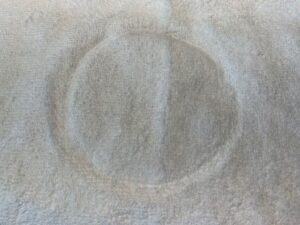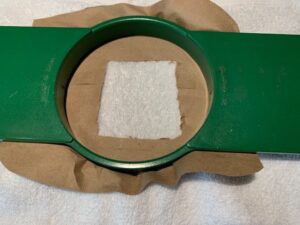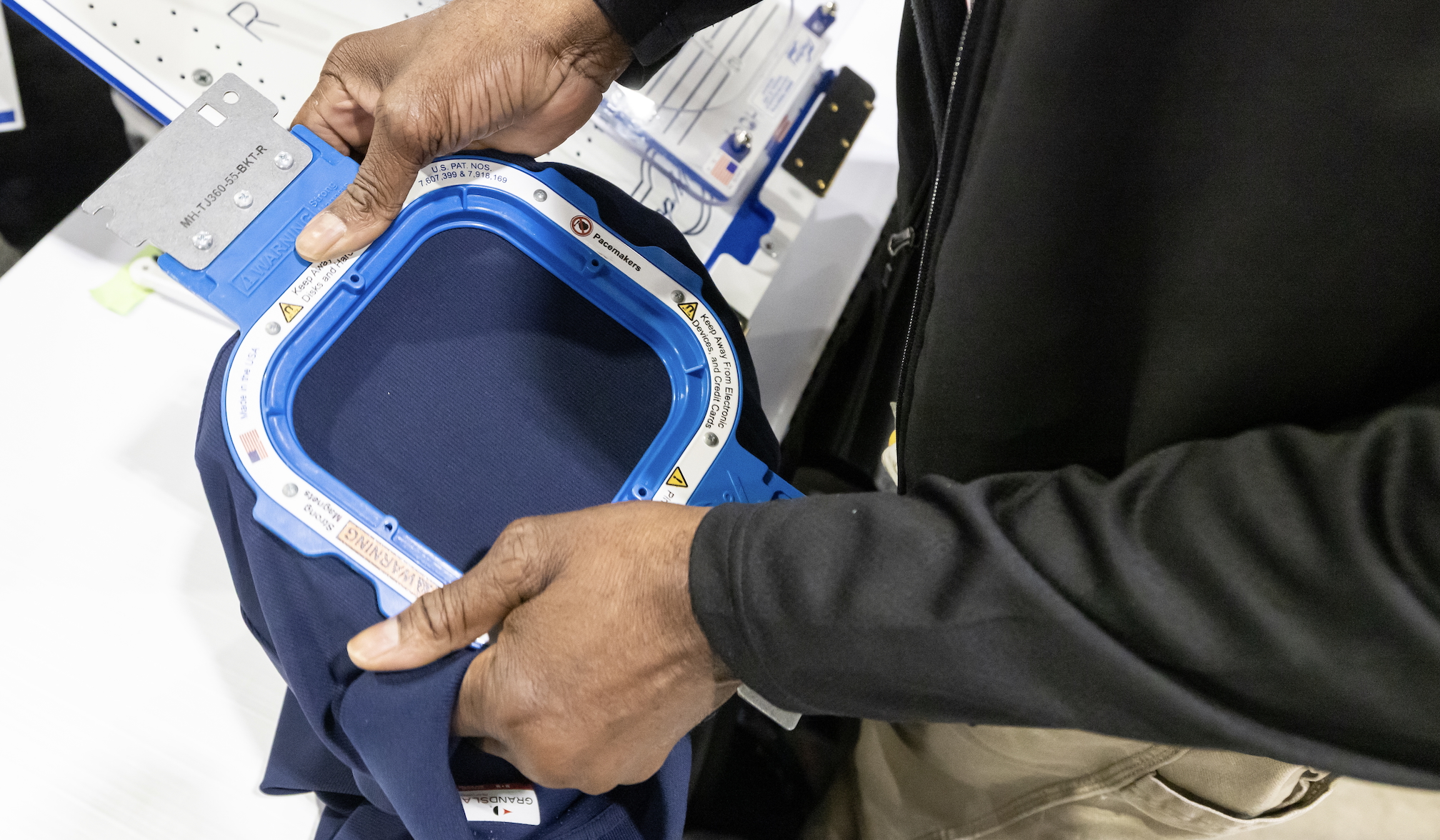A combination of careful hooping and a number of possible corrective measures are the key to bringing this problematic aspect of machine embroidery under control
Modern machine embroidery is both an art and a science, with any number variables and potential pitfalls in the mix. Among the most heartbreaking of these is hoop burn. We’ve all been there. Your machine has finished stitching the design. You hold the hoop up. The embroidery is flawless. Alas, though, when you remove the garment from the hoop you see marks around your stitch out! Is the garment ruined after all your hard work?
In the following except from The Deer’s Embroidery Legacy web site (EmbroideryLegacy.com), the staff at the renowned embroidery industry educator, and equipment, software and digitized designs distributor looks at how to fix problems like these and—better still—avoid having to deal with them in the first place.
What Is Embroidery Hoop Burn?

An example of hoop burn in a terrycloth item. Photo courtesy of The Deer’s Embroidery Legacy
Hoop burn refers to the frustrating shiny mark left on the fabric in the shape of the hoop used when you’ve finished with your stitch out as a result of the fabric fibers having been distorted from the compression and friction from the hoop halves. We all want even, tight (but not too tight!) hooping to ensure it does not shift when stitching an embroidery design. So, what do we do?
All too often we turn those tension screws on our hoop, so it is nice and tight without the fabric in it. Then, we rock, twist and smash to secure them when the fabric is in it. Unfortunately, this can crush the fabric to the point marks may remain when the design is finished.
The root of the problem is the fact the hoop creates friction as it moves under pressure and compaction due to the lack of space available, pressing air and moisture out of the fabric as it’s forced into place. Imagine shutting your fingers in a car door. That’s hoop burn.
Different Fabric Types and Hoop Burn
It’s important to know the type of fabric you’re working with when treating burns. Synthetic and natural fabrics react differently. Though you wouldn’t think it possible, under enough pressure and movement, you can slightly melt and compact petroleum-based fabrics. This can happen to fabrics such as microfiber, nylon or polyester. Think fabrics you can melt even with a low iron.
The resulting marks resemble a rope burn and have the sensation of a burn, though they do not result from burning per se. Friction and pressure make them that way.
With cotton, silk and other “natural” fabrics that rely on moisture to stay soft, things are a bit different. Specifically, hoop burn can result when the hoop is tight enough it presses out the moisture and air in between the fibers making up the fabric you’re working with while also smashing them down to where they’d won’t come back up again.
Removing/fixing Hoop Burn
In virtually all cases, you can either remove hoop burn completely or, at the very least, using a number of simple techniques. What follows are some of the best solutions we have found:
Steam/water spray – Use a clothing steamer or steam iron to steam your clothes quickly. Make sure to hold the steamer or iron at a distance from the fabric. Alternatively, you can spray some water onto the affected area from a spray bottle to make the fabric fibers moist again. Lightly brushing the damp (but not wet) fabric with a soft brush is often helpful.
Laundry – For those garments that can be laundered, run the item through the washer to leave your garment fresh.
Vinegar – Vinegar is often under-used and misunderstood as a household cleaner. Using a dilute solution, spray lightly on your fabric (do not spray on rayon) and then steam with a steamer. Make sure to test natural fabrics in an area you cannot see to ensure there is no color damage. Wash your garment, and you’re all set.
Lint brush – For fabrics like velvet and terry cloth, the best method is often simply using a lint brush or sticky roller to tease up those fibers and loops.
Spray starch – Can also help to rehydrate droopy, dry fibers.
Note, even in those cases where these suggestions don’t quite remove the marks in their entirety, they will help. Again, we suggest testing any treatments on an out-of-the-way corner of the garment or stitching to ensure they are colorfast and can be treated with water. Unfortunately, these methods will not be as helpful when working with non-washable fabrics or leather and vinyl.
Preventing Machine Embroidery Hoop Burn
Of course, as in all things, an ounce of prevention is worth a pound of cure, i.e., the best solution to your hoop burn problems is not allowing hoop burn to happen in the first place. Let’s look at how to do that.

Using a mask to protect the fabric during machine embroidery stitch-out. Photo courtesy of The Deer’s Embroidery Legacy
The best thing you can do is avoid overtightening. This may seem tricky. How do you know when tight is tight enough? Bottom line: a finger-tight turn or two may sometimes be needed, but never use a screwdriver to try and tighten the hoop to the max. This is a waste of time, causes fabric burn and will invariably be harmful when it comes to your embroidery stitch out. For a more in-depth look at proper hooping, click here.
Beyond that, certain special techniques can minimize the damage in especially tricky situations. Granted, they do not necessarily represent a complete solution. However, they can help a project turn out smooth and undamaged. If you find yourself and your work plagued by hoop burn, consider trying the following:
Magnetic Hoops: Easy to use, these do a great job of reducing the chance of marks being left on your fabric. They come with a top and bottom, with extremely powerful magnets embedded in them.
If you are interested in going this route, try Mighty Hoops, (a product our company not only markets, but which we offer with a “bonus” of 25 free professionally digitized designs). They work with many different embroidery machines, are less likely to experience fabric shifting, reduce wrist and arm strain, and make hooping even the hardest fabrics that much easier.
Note: You’ll need to be cautious when handling these kinds of hoops. Snapping your fingers between them will leave a mark! Patients with pacemakers should also exercise caution, as the magnets’ strength can disrupt these kinds of devices.
Floating: Floating is exactly what it sounds like: you float the fabric. This hooping method works best with smaller projects and light fabrics. In short, you hoop a piece of stabilizer and then baste, with stitching or spray, the item you are embroidering to the stabilizer.
Note, this method is not recommended for larger items, such shirts, hoodies and blankets, as these will likely shift during embroidering. The beauty of floating is you are never actually hooping the fabric you’re working with and therefore can’t damage it.
Masking: Another option is making a mask, like a mat in a picture frame, to protect sensitive fabrics, like leather, suede, velvet and silk, from hoop burn. With fabrics that have a nap, like velvet, take an extra piece of the same fabric and lay it nap side down so you are nap to nap. This provides a cushion and also gives the hoop a good grip.
Conclusion: No More Embroidery Hoop Burn!
To summarize: whatever fabric you’re working with, it needs to breathe. Don’t squeeze it! Make sure your hoops can easily close and do not over-tighten. In the event you end up with hoop burn, spraying water or washing the item will fix most issues (depending on the fabric). When faced with an especially tough case, try a new way of holding the fabric, like floating or using magnetic hoops, for easier embroidery.
A family business since 1958, The Deer’s Embroidery Legacy operations cover the length and breadth of the embroidery business, including cutting-edge software, beautiful designs and premium education. Embroidery Legacy’s long list of blue-chip clients has included Coca-Cola, Disney, and, yes, even the equipment manufacturer John Deere. For more on the points covered in this article, which was adapted from the Embroidery Legacy website, visit EmbroideryLegacy.com.





